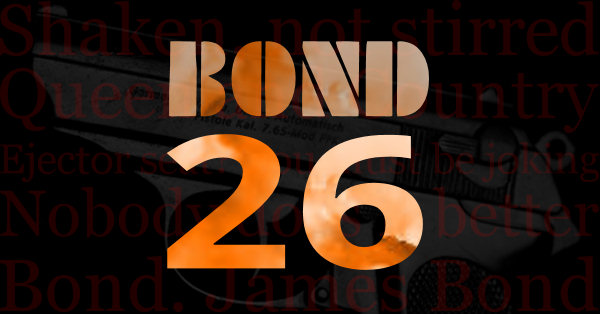Amir Asmar looks at how Daniel Craig’s last outing as 007 dismantled the long-established Bond universe.

Over Ian Fleming’s twelve novels and two short story collections, countless continuation novels by other authors, and 24 official films by Eon Productions, James Bond developed a vast, multi-generational audience that has come to enjoy the many features of the Bond formula. This formula has evolved over the decades; among other things, the films incorporated new technologies as they developed and significantly updated the roles and treatment of women. Also, over the years, the tone of the films fluctuated from semi-serious and gritty to humorous and lighthearted and back; Bond survived at times solely by his wits and strength, while at others, he relied heavily on gadgets. Nonetheless, the Bond basics remained the same throughout Eon’s long-running film series.
In his films, Bond travels to exotic locales, battles audacious adversaries, works with loyal allies from both the United Kingdom and partner countries—including from across the pond at the CIA—loves beautiful women along the way, and beats the odds to deliver victory to queen (now, king) and country. And, most importantly, Bond always lives to fight another day. At the British Secret Service, Bond usually gets his mission assignment from his boss, M, and benefits from support from the Quartermaster or Q, as well as M’s staff, assistant Moneypenny and Chief of Staff Tanner. All these characters have their origins in Fleming’s novels and have become staples of the Bond films.
Then came No Time to Die. This is a film where the producers and scriptwriters purposely undertake the dismantling of the Bond universe—more or less everything Bond fans have loved for generations—and ending with the meaningless, and rather colorless, death of Bond himself. The film first takes a nasty turn in Cuba where Bond watches his longtime friend and CIA partner, Felix Leiter, die after being betrayed by Logan Ash, one of the film’s countless villains. Leiter never dies in any Fleming story, although he is maimed by a shark in the 1954 novel Live and Let Die, events which were brought to the screen in 1989’s Licence To Kill; in the film world, his character in different incarnations has been a recurring ally to four of the Bond actors in ten films. Jeffrey Wright, the actor playing Felix in three of the Daniel Craig films, has arguably given us one of the best interpretations of the role. Instead of keeping Wright’s Felix to continue supporting Bond beyond the Craig era, the producers elected to discard him.
Throwing away the current, highly successful incarnations of supporting characters is not limited to Leiter in No Time to Die. While it remains unclear how Eon will approach the script and production of the next Bond film, one idea bandied about in the Bond fanverse is a complete reboot, which would re-set Bond to an earlier moment in his career. Such a timeline shift would sidestep the mess left by No Time to Die, and it would allow the writers to resurrect all these characters. However, a reboot would could not logically allow the great cast of Ralph Fiennes (M), Naomi Harris (Moneypenny), Ben Wishaw (Q), and Rory Kinnear (Tanner)—or Jeffrey Wright—to return.
Another step in No Time to Die’s dismantling of the Bond formula is the way the film treats M, Bond’s chief in the British Secret Intelligence Service. In the Fleming source material, Bond is characterized as having great affection and respect for M. In the films, M has been played by four actors with varying characteristics and even periodic tensions with Bond; however, mutual respect and resolution of any friction in a way that re-sets the relationship to Fleming’s characterization has always been the norm. In No Time to Die, however, Fiennes’ M is cast as somewhere between an incompetent and a villain, having authorized the creation of Heracles, a genetic weapon, and then blamed for its theft. Bond’s treatment of M in some scenes of No Time to Die is full of contempt. Calling M from Jamaica, Bond starts out “M, Darling, a couple of things…” in a highly glib tone, then continuing with “Mallory, what have you done?” In Bond’s first scene in M’s office, Bond’s first words are “Has this desk gotten bigger, or have you gotten smaller”? The scene is cringe-worthy and out of character for both Bond and M, ending with Bond whispering on his way out, “it’s definitely the same desk.” In a later scene along the Thames, after M asserts that he had to use his judgment with regards to developing the Heracles weapon, Bond declares that “your judgment is the problem.” In addition to the strangeness of Bond disrespecting M this way, inconsistent as it is from the novels and past films, it was gratuitous as M clearly never intended the events of the film, including the vengeful Safin’s theft of the Heracles weapon or the consequences of that theft.
Another bit of this film that helps to undermine the Bond universe is the empty and meaningless death of SPECTRE chief Ernst Stavro Blofeld. Before the Daniel Craig reboot, Blofeld had appeared in five films, and—although his identity is not revealed—he is hinted at in 1981’s For Your Eyes Only. Though presumed dead multiple times, the producers always allowed themselves maneuvering room, so as to permit the possibility of bringing back this fan-favorite villain and the SPECTRE organization. Not only is his death definitive in No Time to Die, it is a meaningless mishap, an accident resulting from Bond having touched the genetic poison aimed at killing Blofeld on Madeleine Swann’s wrist before touching him. Further, the overall storyline of Safin avenging himself against SPECTRE by killing off all of its agents at the party in Cuba, results in the elimination of the entire organization. Only a complete reboot would allow for this fan-favored villainous organization – or Blofeld – to return.
Apart from the film’s dubious ending, there is probably nothing more jarring than Bond’s transformation from living the life of a playboy on the margins of his secret service assignments, to a family man, with a partner and young daughter that he introduces to Nomi, the new 007, in a whisper as “my family.” It doesn’t help that Bond seems to have little on-screen chemistry with Léa Seydoux’s Madeleine, particularly when compared with Vesper Lynd (on the train) or Tracy di Vincenzo (in the barn). The introduction of a young girl four or five years old into the adventure allows the writers to build up intensity as her life is threatened by Safin, forcing Bond to apologize repeatedly, literally begging Safin not to kill her—very out of character. Needless to say, threatening the life of an innocent child to intensify the tension is an artifice that Bond writers have never stooped to before No Time to Die. The child is saved because Safin bizarrely just lets her go.
With regard to Bond’s death at the end of the film, it’s difficult to justify unless the viewer understands that the purpose of the film was to destroy the entire Bond universe, with Bond’s death being the cherry on top. Bond’s death was not necessary; not only did Bond not have to finish off Safin’s island of poison personally—Nomi could have done it—but a convoluted sequence is necessary where British missiles are launched, followed by Safin re-closing the blast doors after Bond had opened them for the missiles. Bond fights Safin and is infected with a version of Heracles aimed at killing his “family” in the process; he kills Safin and re-opens the doors, but injured and weakened has no time to escape.
A more compelling ending would have been Bond escaping the missile volley, returning to the secret service because his infection with the genetic poison prevents him from ever touching, much less living with, his “family.” As his touch would have killed them, Madeleine and Bond’s daughter Mathilde would have stayed outside the Bond narrative in future films, much like the literary Bond’s son with Kissy Suzuki in Fleming’s 1964 novel You Only Live Twice. However, the more compelling question is… if Bond’s survivability is no longer his principal attribute, then what is Bond? The pathos in the scene where Bond says goodbye to Madeleine shortly before the missiles strike Safin’s island is arguably the most un-Bond-like scene in any film. No bravado, no confidence of mission success, no flippant request to keep his martini chilled. Simply, although it was a scene that Craig likely wanted to play, it lacked authenticity.
A brief word about the music in No Time to Die. Although the producers followed tradition by commissioning a pop song for the film’s title, much of the film’s soundtrack is recycled from 1969’s On Her Majesty’s Secret Service. While that soundtrack is excellent and much loved by Bond fans, its use here is a testament to the creative bankruptcy of No Time to Die, apart from the central idea of destroying the entire Bond universe.
I shouldn’t close this column without acknowledging that No Time to Die does have some spectacular sequences. Most fans acknowledge the excellence of two set pieces: the Matera chase and the shoot-out at the SPECTRE party in Cuba. Both are riveting, with intense action and a bit of humor mixed in. The Matera sequence is an adrenaline spike that serves notice that Bond, and his rebuilt Aston-Martin DB5, remain at the top of their game. The Cuba scene has Bond partnering with the beautiful Paloma (Ana de Armas) to infiltrate a party of SPECTRE agents celebrating Blofeld’s birthday to extract a missing scientist for whom both the CIA and MI6 are looking. Bond’s semi-flirtatious romp here is the last we see of the authentic Bond, before he is turned into a family man. I would argue this film is truly awful, despite the great set pieces; the totality of No Time to Die is less than the sum of its parts.
Although largely outside the producers’ control, the six-year period between No Time to Die’s release (October 2021) and that of its predecessor, 2015’s SPECTRE—matching the longest gap between films in Bond history—extended the period of anticipation and amplified this fan’s negative reception of a severely flawed film. Production problems pushed the release date from October/November 2019 to February 2020 and then again to April 2020, by which time the COVID-19 pandemic was shutting down economic activity worldwide. No Time to Die became the first film from a major franchise to be delayed due to COVID-19. While the Bond producers can hardly be blamed for the pandemic and its consequences, the scheduled gap between films—a full four years—was unusually long if you look at the entire series. Moreover, the film experienced early production problems, as both the original director (Danny Boyle) and original composer (Dan Romer) were replaced after work on the film had started. Finally, there is the refusal to consider the completed film’s release via streaming during the pandemic—this alone extended the gap between films by some eighteen months. Not knowing how much I would dislike this film, it would have been a welcome distraction during the dreary days of the lock-downs.
Unlike other entries in the Eon film series that are considered poor by many fans—Diamonds Are Forever, The Man with the Golden Gun, and Die Another Day come to mind—this film is different in that it sets about destroying Bond and his universe. By the end, the writers of No Time to Die had killed off Bond’s closest ally and his principal enemy organization and its leader, they had degraded his relationship with M, turned the erstwhile playboy into a family man before unceremoniously killing him. This leaves the devoted fan in a quandary. What comes next? This production failed to maintain the integrity of Bond and the films’ decades-long successful formula; so how does a fan look forward to the next film? Will the next film further degrade the Bond formula or will it restore respect to Bond’s persona and his world, re-setting them to Fleming-esque authenticity?











October 18th, 2023 at 00:14
Excellent analysis. Unfortunately, believe the producers will insist on destroying the foundation of the franchise, for considering it too politically incorrect. Only a new “owner” would be able to revive the series after the disaster of NTtD.
October 19th, 2023 at 13:34
I completely agree with this analysis. To restart Bond now needs a complete change of approach and taking it back to the books, that’s where the heart lies. I’d also consider a 30 minute opening pre film to land the new universe and new Bond so we get time to adapt before the next film lands a year later. I’m getting older and am losing faith with the Bond leadership to deliver a film before I can’t watch it !
October 20th, 2023 at 15:57
I think that NTTD was actually very good and the deaths that you describe as meaningless were actually very moving. The film is about saying goodbye to the Craig-verse Bond, and the producers took great pains to send him off as an epic Greek hero. I have an article on The James Bond Dossier that explains all the allusions to Greek mythology in NTTD. It explains everything from Swann’s and Ash’s names, to Bond’s sabotaged Land Rover, and the deaths of Leiter and Bond. It is time to leave the Craig-verse behind and start off fresh. Maybe in the Bond 26 universe there will be a Tracy Bond, a Blofeld that isn’t a “foster brother” (ugh – that was the worst) or some entirely new characters and elements. I don’t think that NTTD ruined Bond. The Craig-verse Bond had played out and it was time to end the arc.
October 22nd, 2023 at 06:43
Paraphrasing Cubby Broccoli “When in doubt go back to Fleming.” Reboot should portray an already established, experienced 007(like Sir Sean in Dr. No)
November 7th, 2023 at 14:29
I could not agree more with this piece. The best thing I’ve read yet about how this film destroyed the franchise.